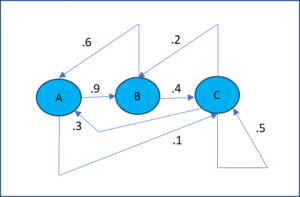When the posterior has a known distribution, as in Analytic Approach for Binomial Data, it can be relatively easy to make predictions, estimate an HDI and create a random sample. Even when this is not the case, we can often use the grid approach to accomplish our objectives (see Creating a Grid). Unfortunately, sometimes neither of these approaches is applicable. On this webpage, we demonstrate how to use a type of simulation, based on Markov chains, to achieve our objectives.
In a Markov chain process, there are a set of states and we progress from one state to another based on a fixed probability. Figure 1 displays a Markov chain with three states. E.g. the probability of transition from state C to state A is .3, from C to B is .2 and from C to C is .5, which sum up to 1 as expected.
Figure 1 – Markov Chain transition diagram
The important characteristic of a Markov chain is that at any stage the next state is only dependent on the current state and not on the previous states; in this sense it is memoryless.
For our purposes here, you don’t need to know more about Markov chains, but if you are interested in learning more, click here.
Topics
References
Lee, P. M. (2012) Bayesian statistics an introduction. 4th Ed. Wiley
https://www.wiley.com/en-us/Bayesian+Statistics%3A+An+Introduction%2C+4th+Edition-p-9781118332573
Gelman, A., Carlin, J. B., Stern, H. S., Dunson, D. B., Vehtari, A., Rubin, D. B. (2014) Bayesian data analysis, 3rd Ed. CRC Press
https://statisticalsupportandresearch.files.wordpress.com/2017/11/bayesian_data_analysis.pdf
Marin, J-M and Robert, C. R. (2014) Bayesian essentials with R. 2nd Ed. Springer
https://www.springer.com/gp/book/9781461486862
Jordan, M. (2010) Bayesian modeling and inference. Course notes
https://people.eecs.berkeley.edu/~jordan/courses/260-spring10/lectures/index.html
Reich, B. J., Ghosh, S. K. (2019) Bayesian statistics methods. CRC Press
